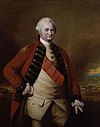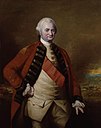The Governor of Bengal was the head of the executive government of the Bengal Presidency from 1834 to 1854 and again from 1912 to 1947.[1][2] The office was initially established on 15 November 1834 as the "Governor of the Presidency of Fort William in Bengal" and was later abolished on 1 May 1854 and the responsibility of the government of the Presidency was vested in the two Lieutenant Governors of the North-Western Provinces and Bengal.[lower-alpha 1] On 1 April 1912 the office of Governor of Bengal was restored and lasted till the Partition of India in 1947 and was replaced by the office of the Governor of West Bengal in West Bengal.
Quick Facts Governor of Bengal, Status ...
Close
The history of the office of the Governor of Bengal dates back to 1644, when Gabriel Boughton procured privileges for the East India Company which permitted them to build a factory at Hughli, without fortifications. Various chief agents, governors and presidents were appointed to look after company affairs in the Bay of Bengal. In 1773, Warren Hastings was appointed as the first Governor General of the Presidency of Fort William in Bengal following the enactment of the East India Company Act of 1772.[3]
In 1833, the first Government of India Act was passed enacting that the three presidencies of Fort William in Bengal, Bombay and Madras along with a new "Presidency of Agra", were to be a part of a new "India", and the new office of Governor-General of India along with the Government of India was established. The Governor of Bengal served as the Governor-General of India in addition to his own office.[4]
This setup lasted until the enactment of the Government of India Act 1853, following which, the office of the Governor of Bengal was abolished. From this point onwards the Presidency of Fort William existed only as a nominal administrative division without a government or a head of government. Rather it was made up of two separate lieutenant governorships with separate governments under the Lieutenant-Governor of the North-Western Provinces and the Lieutenant Governor of Bengal. North-Western Provinces were later separated from the Presidency and united with the Oudh Province, leaving only the Bengal Division. This setup was abolished in 1912 after a proclamation by King-Emperor George V was made in 1911 re-establishing the office of the Governor of the Presidency of Fort William in Bengal.[5]
In 1947, India was partitioned and the new province of West Bengal was formed following the second partition of Bengal. C. Rajagopalachari was appointed as the first Governor of West Bengal. When the constitution of India came into effect on 26 January 1950, the office of Governor of West Bengal become a ceremonial position.
In 1932 the position came with an annual salary of approximately £114,000 (equivalent to £8,241,000 in 2021), a sumptuary allowance of £25,000 (equivalent to £1,807,000 in 2021) and a grant of £100,000 (equivalent to £7,229,000 in 2021) to cover his staff's wages. In addition to his personal staff he had 120 servants, a seventy-man mounted bodyguard, and a brass band. There were cars, two special trains, a yacht and a house boat.
In 1644 Gabriel Boughton, procured privileges for the East India Company which permitted them to build a factory at Hughli, without fortifications. In 1650, the factories of Balasor and Hughli were united. On 14 December 1650, James Bridgman was appointed as the chief of the factories. However, in 1653, Bridgman left suddenly and Powle Waldegrave assumed his charge.
On 27 February 1657, the company resolved its holdings into four agencies: Fort St. George, Bantam, Persia, and Hughli. George Gawton was appointed as the Agent of Hughly. Additional three factories in Ballasore, Cassambazar and Pattana were put under the Hughly agency. In 1658, Johnathan Trevisa was appointed as the second to Gawton and was meant to succeed him after the latter's death. On 6 February 1661, the company reduced the Hughly agency under the Fort St. George, and then agent Trevisa was made the "Chief of Factories in the Bay of Bengal".
On 24 November 1681, William Hedges was appointed as the "Agent and Governor for the affairs of the East India Company in the Bay of Bengal". On 21 December 1684, William Gyfford who was the President and Governor of Fort St. George was given the additional charge of Bengal due to increasing mismanagement. John Beard was appointed as the "Agent and Chief in the Bay of Bengal" and become the subordinate to Gifford.
On 20 December 1699, the Court of Directors (London East India Company) appointed then Agent Charles Eyre was made the " President and Governor of Fort William, in Bengal". The President or Chief in the Bay of Bengal for the English East India Company was Sir Edward Littleton in whose commission and instructions, dated 12 January 1698, it was also stated that power had been obtained from his Majesty to constitute him the "Minister or Consul for the English Nation" with all powers requisite thereunto.” Littleton was later deposed by the Court of Directors in 1703.
The union of the two East India Companies took place on 23 July 1702. For united trade in Bengal, a Council was appointed, of which Nathaniel Halsey and Robert Hedges were to take chair each in their week alternatively as per the dispatch from United Company on 26 February 1702. In a dispatch of 12 February 1704, it was ordered that if Beard shall die, no one will be appointed as President to succeed him. After the departure of John Beard to Madras, Ralph Sheldon assumed the position of Chief of Council, and his appointment was confirmed in a dispatch of 7 February 1706.
On 30 December 1709, Anthony Weldon was appointed as the "President in the Bay, and Governor and Commander-in-Chief for Fort William, in Bengal" for the United East India Company. His appointment was later revoked and was supposed to be succeeded by Sheldon. Since Sheldon had died by the time dispatch arrived in Bengal, John Russell was ordered to succeed as the Governor. By a letter of 8 May 1771, the Court appointed Warren Hastings to be Governor of Bengal.
More information Name, Portrait ...
| Name |
Portrait |
Took office |
Left office |
Remarks |
Appointer |
| Chief of the factories of Balasore and Hughli |
East India
Company
 |
| James Bridgman |
|
14 December 1650 |
1653 |
|
| Powle Waldegrave |
|
1653 |
1657 |
|
| Agent of Hughly Agency |
| George Gawton |
|
27 February 1657 |
11 September 1658 |
|
| John Trevisa |
|
11 September 1658 |
6 February 1661 |
|
| Chief of Factories in the Bay of Bengal |
| John Trevisa |
|
6 February 1661 |
31 January 1662 |
|
| William Blake |
|
31 January 1662 |
24 January 1668 |
|
| Shem Bridges |
|
24 January 1668 |
7 December 1669 |
|
| Henry Powell |
|
7 December 1669 |
? |
|
| Walter Clavell |
|
~June 1672 |
7 August 1677 |
Died in office |
| Mathias Vincent |
|
7 September 1677 |
~July 1682
(position superseded) |
Deposed in July 1682 |
| Agent and Governor
for the affairs of the East India Company
in the Bay of Bengal |
| Sir William Hedges |
|
24 November 1681 |
~ August 1684 |
Deposed in August 1864 |
| Agent and Chief in the Bay of Bengal |
| John Beard |
|
21 December 1683 |
28 August 1685 |
Died in office |
| Job Charnock |
|
~ April 1686 |
10 January 1693 |
Died in office |
| Francis Ellis |
|
10 January 1693 |
January 1694 |
|
| Charles Eyre |
|
25 January 1694 |
1 February 1699 |
Left for England in 1699 |
| John Beard |
|
1 February 1699 |
20 December 1699
(position superseded) |
Second to Eyre |
| President and Governor of Fort William, in Bengal |
| Sir Charles Eyre |
|
20 December 1699 |
7 January 1701 |
Left on account of health issues |
| John Beard |
|
7 January 1701 |
7 July 1705 |
Died in Office |
| President in the Bay, and Governor and Commander-in-Chief for Fort William, in Bengal |
| Anthony Weldon |
|
30 December 1709 |
4 March 1711 |
Appointment revoked by the Court of Directors
Resigned in March 1711 |
| John Rusell |
|
4 March 1711 |
3 December 1713 |
Dismissed by the Court |
| Robert Hedges |
|
3 December 1713 |
28 December 1717 |
died in office |
| Samuel Feake |
|
12 January 1718 |
17 January 1723 |
Left for England due to illness |
| John Deane |
|
17 January 1723 |
30 January 1726 |
Returned to England |
| Henry Frankland |
|
30 January 1726 |
25 February 1732 |
Returned to Europe |
| John Stackhouse |
|
25 February 1732 |
29 January 1739 |
Resigned |
| Thomas Broddyll |
|
29 January 1739 |
4 Feb 1746 |
Left for England |
| John Forster |
|
4 Feb 1746 |
March 1748 |
Died in office |
| William Barewell |
|
18 April 1748 |
1749 |
Dismissed by the Court |
| Adam Dawson |
|
17 July 1749 |
1752 |
Dismissed by the Court |
| William Fycthe |
 |
5 July 1752 |
8 August 1752 |
Died in Office |
| Roger Drake |
|
8 August 1752 |
20 June 1758 |
Deposed by the Court |
| Col. Robert Clive |
 |
27 June 1758 |
23 January 1760 |
Resigned |
| John Zephaniah Holwell |
 |
28 January 1760 |
27 July 1760 |
Handed over to Vansittart who was appointed on
23 November 1759 to the office |
| Henry Vansittart |
 |
27 July 1760 |
26 November 1764 |
Returned to England |
| John Spencer |
|
3 December 1764 |
3 May 1765 |
|
| The Lord Clive |
 |
3 May 1765 |
20 January 1767 |
Returned to England |
| Harry Verelst |
|
29 January 1767 |
24 December 1769 |
Retired from the service |
| John Cartier |
|
26 December 1769 |
13 April 1772 |
|
| Warren Hastings |
 |
13 April 1772 |
20 October 1773
(office superseded) |
Appointed as the Governor-General of Fort William
in Bengal in 1774 |
Close






